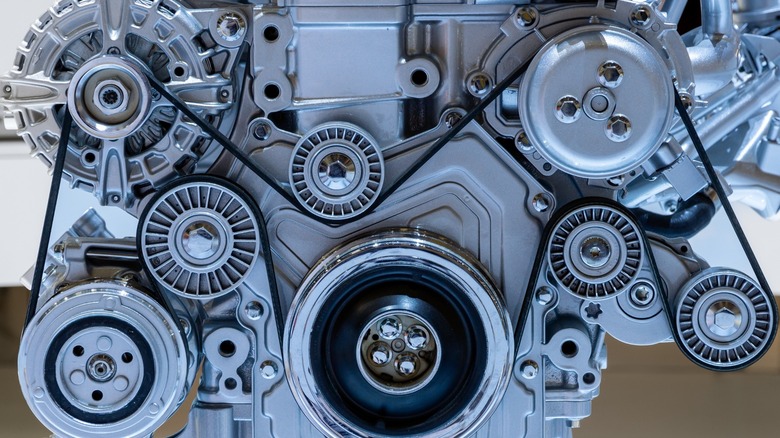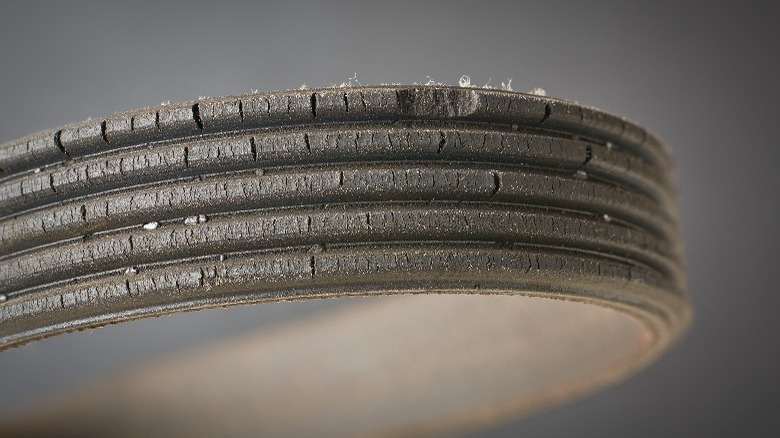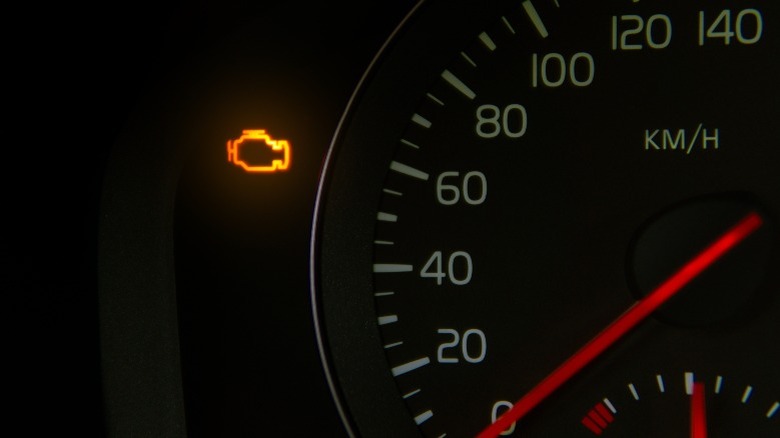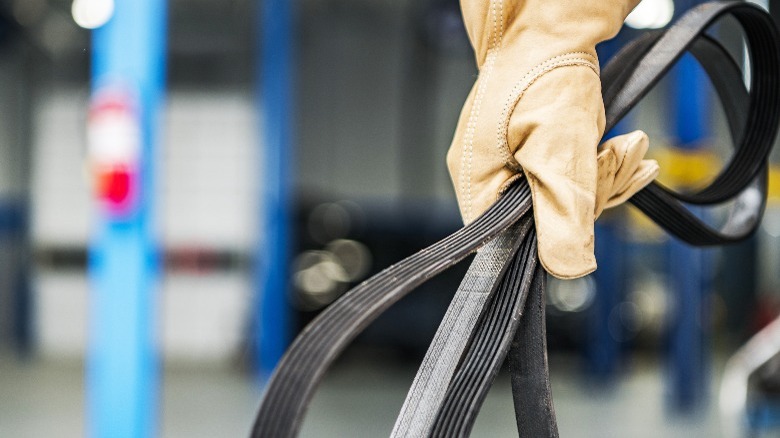5 Signs Your Engine's Serpentine Belt Needs Replacing
Your car's serpentine or drive belt is a vital engine component. It's responsible for providing power to various accessories, including the air conditioning compressor, power steering pump, and the water pump. The source of that power is the crankshaft, which spins as the pistons inside your engine move up and down. The serpentine belt slips over the crankshaft pulley and connects to various other pulleys, transferring that power to accessory pumps and components like the alternator.
While the serpentine belt is a pretty robust piece of equipment, it's subject to wear and tear over time. Most manufacturers recommend replacing the drive belt every 60,000 to 100,000 miles, depending on your make and model and the belt's condition. However, sometimes, these belts degrade earlier than they should or they become damaged by outside contaminants. In these cases, the belt may fail, leading to various mechanical malfunctions, including things like a dead battery or a lack of power steering. It's important to monitor your serpentine belt's condition regularly to avoid these issues and help keep your engine in tip-top condition. But what exactly do you need to look out for, and what are the most common signs that you need to replace the belt? Let's dive in and find out. From cracks and splits to strange noises and an overheating engine, here are five signs that it's time to replace your engine's serpentine belt.
The belt is frayed, cracked, or otherwise damaged
One of the first and most common signs that you need to replace your serpentine belt is physical damage to the belt itself. We mentioned that engine drive belts are pretty durable. They're designed to last for tens of thousands of miles, but they degrade over time, thanks to the extreme conditions inside your engine bay.
Some of the most prevalent types of damage you're likely to see on a serpentine belt include things like cracks, fraying, missing chunks, and glazing. These defects can form for various reasons, including malfunctioning or damaged pulleys and excessive heat. They may also appear if the belt was incorrectly installed. It's important that you tension the belt properly when installing it. If it's too loose or too tight, it's likely to develop damage due to things like friction and/or excess movement.
That said, these issues are typically due to age and wear. It's vital that you monitor your drive belt's condition regularly to keep an eye out for damage. When checking the belt's tension, you should be able to turn it sideways roughly 90 degrees — any more or less, and the belt is too tight or too loose. Check for cracks, fraying, missing chunks, and glazing. If you notice anything wrong with the belt, you should replace it yourself or visit a professional mechanic for the service.
You hear strange noises coming from the engine bay
Another common sign that it may be time to replace your serpentine belt is strange noises coming from the engine bay. When your engine drive belt is damaged, installed incorrectly, or just worn-out, it's not unusual to hear sounds like high-pitched squealing, chirping, or squeaking. Your car can make a lot of different sounds, and many of them can indicate various problems. It's important to pay attention to the type of noise your vehicle makes and the area where it seems to originate, as doing those things can help you identify the source of the issue.
The most common sound you're likely to hear with a bad serpentine belt is high-pitched squealing or chirping, especially when first starting the engine. This problem can occur for various reasons, but it's most frequently due to wear and tear or improper belt tension. Squealing and rattling noises can also indicate problems with the belt tensioner or accessory pulleys, and if you notice these issues, you should visit a professional repair technician for an inspection.
It's worth noting that other malfunctions can cause your vehicle to squeak and squeal, and it's common for things like power steering failure to cause your car to squeak while turning. Due to the fact that various problems can cause these symptoms, it's critical that a professional mechanic inspects your vehicle. Not all of the culprits for these issues require expensive repairs, but they can be dangerous, and if you ignore them long enough, you'll likely face a costly repair bill.
Your engine is overheating
Another sign that you may be due for a serpentine belt replacement is engine overheating. That's because, in many cars, one of the accessories powered by the drive belt is your car's water pump. The water pump is part of your vehicle's engine cooling system and is responsible for pumping coolant through the engine block to absorb and remove excess heat. If the serpentine belt is damaged, stretched, or overly tight, your engine's water pump may not be able to function properly. A damaged or improperly tightened belt may not be able to grip the pump's pulley correctly, contributing to reduced pump efficiency and even damage. If the belt breaks completely, not only will your car's cooling system stop working altogether, leading to potentially disastrous engine damage, but all of your other accessory components will also fail.
That's a serious problem and one that you should not ignore. The tricky thing is your car's engine can overheat for various reasons. A damaged or broken serpentine belt is only one of the potential causes of an overheating motor. It can be difficult to identify the ultimate source of an overheating engine. But regardless of the problem's origin, an overheating engine is extremely dangerous for you and your vehicle. Any time you notice signs of engine overheating, you should pull over, call for help, and prioritize visiting a professional mechanic as soon as possible.
Your power steering and/or air conditioning stops working
Your car's water pump isn't the only engine accessory driven by the serpentine belt. The belt is also responsible for providing power to several other components, including the power steering pump, air conditioning compressor, and alternator. Each of these parts is vital for different systems in your car. The power steering pump sends hydraulic fluid through the steering system and helps ensure that your steering wheel is relatively easy to turn. The AC compressor is responsible for compressing gaseous refrigerant into liquid before sending it through the rest of your vehicle's air conditioning system.
If the serpentine belt malfunctions or becomes damaged, it may be unable to power these components properly. When this occurs, you may experience issues like a stiff steering wheel, loud groaning noises while turning the wheel, intermittent cabin cooling, or the failure of both systems entirely. Just like with the water pump, a broken or improperly tightened belt may be unable to grip these accessories' pulleys properly or spin them at all. While neither power steering nor air conditioning are essential vehicle functions, they do make your life easier and more comfortable, and if your power steering fails while driving, it could result in dangerous accidents. If you notice these symptoms, you should contact a professional mechanic immediately and schedule a time for a complete inspection.
Warning lights appear on your dash
In addition to mechanical problems and performance issues, you may notice that warning lights appear on your dash if you need to replace your serpentine belt. In many cases, the light may be a battery warning light. That's because the alternator is one of the components that gets its power from the drive belt. Your engine's alternator is responsible for charging your 12-volt battery as you drive, as well as for supplying energy to your vehicle's electrical components, like the lights, power windows, and radio. If the serpentine belt fails, the alternator may not get the power it needs to perform its job, resulting in a drained car battery and malfunctioning electronics.
Outside of a battery warning light, you may notice a check engine light (CEL) appears on your dash. The CEL is designed to warn you when something is wrong with your vehicle's engine or a related system, and it displays diagnostic trouble codes (DTCs) that can help you pinpoint the issue. A malfunctioning or worn-out serpentine belt may trigger your car's CEL for various reasons. If the computer detects a problem with any of the accessories powered by the belt, or if it notices things like excessive engine heat or battery drain, it may activate the light, notifying you that something is wrong and prompting you to get an inspection.
How much does it cost to replace a serpentine belt?
Considering that the serpentine belt is such a vital engine component, and that its failure can result in so many problems, you may be wondering if it's expensive to replace. Fortunately, serpentine belt replacement is relatively cheap and straightforward. In fact, replacing your drive belt(s) is one of the best DIY engine maintenance tasks that you can do at home. It doesn't require overly expensive or niche tools, and even novices should be able to handle the project with minimal hassle. A new serpentine belt can cost between $20 and $80, but most belts fall on the cheaper end of that range. If you choose to perform the replacement yourself, your only expense should be the belt — as long as you have access to a couple basic tools, that is.
If you prefer to let a professional handle the job for you, don't worry — serpentine belt replacement still isn't very expensive. Including parts and labor, you'll most likely pay between $75 and $150 dollars for a mechanic to replace the belt for you. The exact price you pay will depend on your car, whether you visit a dealership or an independent shop, and the labor rates in your area.






